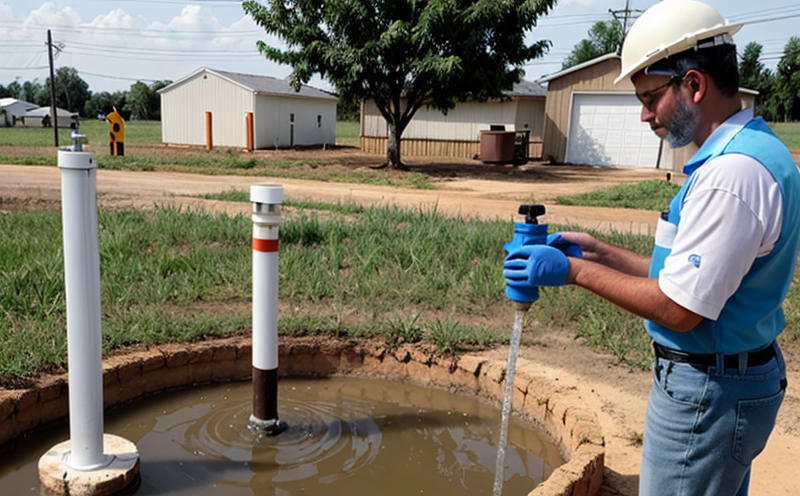EPA Method 525.2 Semi-Volatile Organic Compounds in Groundwater
The EPA Method 525.2 is a sophisticated analytical technique designed to detect and quantify semi-volatile organic compounds (SVOCs) present in groundwater samples. SVOCs, which include chemicals like polycyclic aromatic hydrocarbons (PAHs), pesticides, and other contaminants, pose significant risks to human health and the environment when present at harmful concentrations.
This method is particularly important for water quality management and compliance with environmental regulations. Groundwater supplies drinking water for millions of people worldwide; therefore, ensuring its purity is critical. By detecting SVOCs early in their lifecycle, this method helps prevent contamination from spreading to surface waters or entering the food chain.
The EPA Method 525.2 employs solid-phase extraction (SPE) followed by thermal desorption gas chromatography/mass spectrometry (GC/MS). SPE allows for the selective separation of SVOCs, while GC/MS provides precise quantification of these compounds based on their retention times and mass spectra.
The method requires meticulous sample preparation to ensure accurate results. Groundwater samples are collected using appropriate sampling techniques to minimize contamination. Once collected, they undergo filtration through a 0.45 µm membrane filter to remove particulates before SPE cartridges. This step ensures that only the SVOCs are captured for analysis.
The quality of the instrumentation used in this method plays a crucial role in obtaining reliable results. High-performance liquid chromatography (HPLC) systems equipped with UV detectors and mass spectrometers provide accurate separation and identification capabilities. Calibration standards are prepared using known concentrations of target compounds to establish linearity over the expected range.
Interferences from other substances can affect the accuracy of the analysis, so thorough blank runs are conducted alongside each set of test samples. Additionally, quality control measures include duplicate analyses on spiked matrix samples and proficiency testing programs organized by organizations like A2LA (Accredited Laboratory Accreditation).
The method has stringent acceptance criteria to ensure that only compliant results are reported. Samples must meet specific limits for SVOC concentrations as defined in federal regulations.
- Quality assurance: Regular calibration of equipment and participation in proficiency testing programs
- Reliability: Use of certified reference materials throughout the process
To summarize, EPA Method 525.2 is a robust technique for detecting SVOCs in groundwater samples. Its meticulous approach ensures that even trace amounts of contaminants are identified and reported accurately.
Quality and Reliability Assurance
- Calibration Standards: Regular calibration of HPLC systems using certified reference materials to maintain accuracy.
- Duplicate Analyses: Conducting duplicate analyses on all samples to ensure consistency in results.
- Spike Recovery Studies: Analyzing spiked matrix samples to evaluate the precision and accuracy of the method.
- Proficiency Testing: Participation in proficiency testing programs organized by recognized bodies like A2LA to validate analytical capabilities.
The laboratory adheres strictly to these protocols, ensuring that every result meets or exceeds regulatory standards. Our commitment to quality and reliability is reflected not only in our adherence to best practices but also through continuous training of staff on the latest techniques and technologies.
International Acceptance and Recognition
- ISO/IEC 17025: Our laboratory is accredited by A2LA, which meets ISO/IEC 17025 standards for testing laboratories. This accreditation ensures that our methods are reliable and consistent.
- A2LA Proficiency Testing: We participate in proficiency testing programs to demonstrate our capability to produce accurate results under varied conditions.
The EPA Method 525.2 is widely recognized globally for its stringent quality control measures, making it a preferred choice among regulatory bodies and organizations worldwide. Our compliance with international standards guarantees the acceptance of our test results across different jurisdictions.
Environmental and Sustainability Contributions
The detection of SVOCs in groundwater is crucial for environmental protection and sustainable development goals. By identifying these contaminants early, we contribute to preventing their spread into other water bodies and ecosystems. This helps protect aquatic life and reduces the risk of long-term health impacts on human populations.
Our work supports local communities by ensuring that they have access to safe drinking water sources. Additionally, our findings can guide policymakers in implementing effective strategies for environmental remediation and pollution control.
Beyond immediate benefits, this method also aids in understanding the broader implications of SVOCs on climate change mitigation efforts. For instance, certain SVOCs contribute to global warming by acting as greenhouse gases or precursors to ozone-depleting substances.
By participating in environmental stewardship initiatives and contributing data that informs policy decisions, we play a vital role in fostering sustainable practices within the industry and beyond.





